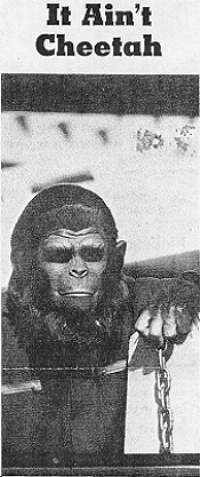CUE November 18-24,
1974
TV
MIKE
JAHN
Something
less than two years ago I spoke with Paul Williams, the pop singer,
who was filled with stories of the wonder of his first major acting
assignment: playing an orangutan in the film "Battle for the Planet
of the Apes."
During the shooting, Mr. Williams rose
at 3:30 a.m., then stayed in makeup for three hours. During one such
session, the makeup man, Kenny Chase, began discussing at length the
merits of what was the favorite drink of both of them, the
margarita. "He drove me crazy talking about margaritas," Mr.
Williams said. "By noon I couldn’t take it anymore. I was really
freaked out. I grabbed Kenny and pulled him into my car."
The car was a 1935 Bugati, "not an
inconspicuous car in any case, but here is this Bugati driving down
Pico Boulevard at lunchtime with an orangutan behind the wheel. We
drove to the Casa Escabar and went inside. Kenny took me by the arm
and went up to the maitre d’. He asked him, ‘Can we have a
table in a dark corner? We want to be alone.’"
 Nearly
two years later, and more than seven since the whole "Planet of the
Apes" phenomenon began, men and women in ape costumes still can be
found bouncing around the Hollywood Hills. After five
highly successful movies, Pierre ("Bridge Over
the River Kwai") Boulle’s creation is a successful weekly
television series. And, as was the case with four of the five movies,
it stars Roddy McDowall in the role of the friendly, science-minded
chimpanzee.
Nearly
two years later, and more than seven since the whole "Planet of the
Apes" phenomenon began, men and women in ape costumes still can be
found bouncing around the Hollywood Hills. After five
highly successful movies, Pierre ("Bridge Over
the River Kwai") Boulle’s creation is a successful weekly
television series. And, as was the case with four of the five movies,
it stars Roddy McDowall in the role of the friendly, science-minded
chimpanzee.
One day recently, Mr. McDowall was preparing for shooting.
"It’s hard to say how it’s going," he said. "It isn’t
like doing a film which you finish, look at, and then have a point of
view about. With a TV series you’re working so hard and
it’s being shown at the same time. It’s a rather different
situation from anything I’ve been involved with before. We just
started the 11th episode this week, and have 13 more to do to
complete the season. It’s very pleasant. The people are very
nice, but it’s hard work."
What precisely makes "Planet of the
Apes" hard work? "It’s a very challenging acting assignment,"
Mr. McDowall said. "The physicalization is different, because you are
dealing somewhat with animal movements. And it’s not easy being
encased in all that rubber for that length of time and manipulating
it so that it’s alive."
How long must the actor remain in
costume? "I work four days a week," he explained. "Three hours for
makeup. After the first hour and a half, before the chin is put on, I
eat breakfast. Then I don’t get any more solid food until the
makeup is off, usually 12 hours later.
"When we started shooting in June, it
was boiling. Even now it’s still pretty hot. You perspire, and
that breaks the glue. I have an air-conditioned motor home which I
run into between takes."
The basic principle of the show is that
humans nearly destroyed themselves through technology; the apes
evolved into the dominant species, and they keep the few remaining
and slightly dull-witted humans in a position of servitude. There is
a lot of playfulness, such as having an ape speculate about what
would happen if you chained an infinite number of humans to an
infinite number of typewriters.
(Incidentally, that experiment has been
tried, and the result goes by the name of "The Village Voice.")
Mr. McDowall says that despite the
Darwinian implications, there has been no rumbling from the Bible
Belt. "Even in the movies I don’t remember any sort of uproar
about that," he says.
The "Planet of the Apes" phenomenon
sells not only movies and TV shows, but more than 300 different kinds
of items, including toys, games, dolls, books, wastebaskets,
t-shirts, doll cut-out books, bubble gum, saucers and plates,
transistor radios, and masks, some of them running to $60.
According to Selwyn Rausch, a New York
merchandiser who is responsible for this aspect of the "Apes" craze,
"by the end of this year we estimate $100-million gross sales in all
kinds of ‘Ape’-related merchandise.
"Why anyone would want a ‘Planet
of the Apes’ wastebasket I don’t know," he says, "but
they’re selling like crazy."
Back
to Who am I and How Did I Get to Be That
Way?
Home to
Michael Jahn's New
York